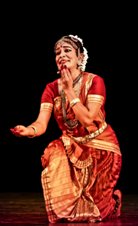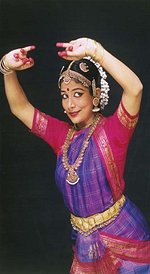
Thyagaraja
Bhagavad Anubhavam
- B Venkat,
Vishakapatnam
e-mail: lasya.poorna@gmail.com
March 6, 2010
 Kalabharathi,
Visakhapatnam, is the cultural hub of the city of destiny, for the audience
and artistes to come together to enjoy art. On the 4th of January 2010,
Bharatanatyam dancer Divya Devaguptapu, a sishya of the Dhananjayans, presented
Thyagaraja Bhagavad Anubhavam. Thyagaraja Aradhana Trust brought this performance
on the eve of Thyagaraja Aradhana Mahotsavam. Kalabharathi,
Visakhapatnam, is the cultural hub of the city of destiny, for the audience
and artistes to come together to enjoy art. On the 4th of January 2010,
Bharatanatyam dancer Divya Devaguptapu, a sishya of the Dhananjayans, presented
Thyagaraja Bhagavad Anubhavam. Thyagaraja Aradhana Trust brought this performance
on the eve of Thyagaraja Aradhana Mahotsavam.
What we normally
get to see in the classical dance programs are dance dramas, arangetrams,
or dance recitals with selected items. Divya presented a theme by way of
bringing to the audience Thyagaraja compositions depicting the journey
of the saint as she visualized it. Divya researched Saint Thyagaraja's
compositions and placed them in three parts or three stages of the journey.
The three parts thus constitute:
A devotee's
"quest"
His total
dedication and "yearning" for the Lord's acceptance, and
"Attainment"
of the Lord's Divine Grace.
If the applause
from the rasikas is an indication of success, she can be happy she achieved
the purpose of presenting the theme. Her work is in progress and Divya
makes it a point to improve her theme with any scholarly inputs that may
come her way. The neat selection of the kirtanas were placed well to provide
a sort of time line, story and narration to the program.
Part 1
Invoking Lord
Ganesha with a sloka from Prahlada Bhakthi Vijayam and "Sri Ganapathini"
in Ragam Sourashtra set to adi talam, Divya chose a pancharatna "Sadhinchaney
O Manasa," giving an appropriate start to the devotional journey. The
kirtana explains Krishna Leela and goes on to depict the adorable nature
of Lord Rama. With "manas" chosen to be the bridge of the theme, it does
justice to the artiste's exploration and journey to "Soham."
Part 2
In the "Anubhavam,"
the yearning and the frustration at not being able to accomplish Sri Rama
Kataksham is brought about by choosing the three krithis, "Kshirasagara...,"
"Chani Todi..." (Bring Him along with you) and "Nannu Vidachi…"
(Leaving me). Perhaps the third krithi could be in part three.
In "Chani
Todi" where "manas" was assigned to bring the Lord, Divya suggestively
incorporated Thyagaraja talking to his mind as he would to a sakhi by showing
one hand, and then guiding "manas" not to wander and stay focused in "sending
the message." As a Kuchipudi artiste, this reminded me of how Satyabhama
in the pravesa daru narrates to "lalana.." her plight through relevant
hasta mudra.
Part 3
"Intakanna
anandam..." (what else can be more joyous), attaining of Lord Rama's
grace provides the artiste an opportunity to peak and enact Thyagaraja
in His presence. "Sohamainadey Chalu" (attaining Oneness is all
that is needed) is the fulfillment stage and "oneness." What wonderful
"transport" from praying to the Lord "not to leave" to "Sohamainadhey
Chalu"! This subtle shift from "attaining" to "permanence" is entirely
a God sent message.
 Her
jatis were crisp and efficient. Quick changes in the phases from the energetic
pace of the jatis to the intense expression of bhava (demanded by
sahityam) showcased her talent as a dancer and choreographer. A
very innovative approach - repeated depiction of Lord Rama as He resides
in our mind, holding the bow and arrow, invoked bhakthi. This image would
remain etched in one's mind even after the program. A notable feature of
the artiste was her expressive reach of eyes that connected her to even
those sitting in the back rows in the hall. Her
jatis were crisp and efficient. Quick changes in the phases from the energetic
pace of the jatis to the intense expression of bhava (demanded by
sahityam) showcased her talent as a dancer and choreographer. A
very innovative approach - repeated depiction of Lord Rama as He resides
in our mind, holding the bow and arrow, invoked bhakthi. This image would
remain etched in one's mind even after the program. A notable feature of
the artiste was her expressive reach of eyes that connected her to even
those sitting in the back rows in the hall.
Divya created
space to show her versatility by the interpretation of "Chani Todi"
from "bhakthi" to "romantic mission." Taking a cue from the pallavi that
reads like a Padam, she explores the theme by engaging manas as the sakhi;
a messenger to the beloved. The connotations of Madhura Bhakthi proved
an ideal opportunity to show her mettle.
Divya in her
portrayal transcends, becomes the Saint himself, to attain Lord Rama, in
"Ninnu baasi ara nimisha morva nura." (Without you, cannot tolerate
for even a fraction of a second). To me, this proved to be the highlight
of her performance. It is at this stage that Divya, Saint Thyagaraja, the
audience in the hall all became "One" - Sohamanidhi Chalu.
Nattuvangam
by Guru Shanta Dhananjayan, vocal by Arun Gopinath, violin by Sunil Bhaskar,
and mridangam by Jaya Sankar, expertly enabled the performance to rise
to the occasion. Credit should also go to Padmaja Avvaru, Kanakam Devaguptapu
for the support in the research and notes.
B Venkat,
a student of Bala Kondala Rao, is a Kuchipudi dancer in the Dr. Vempati
Chinna Satyam style. |

